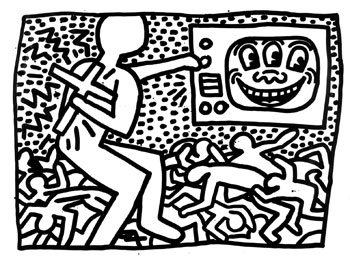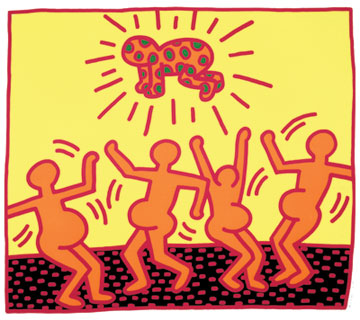Summer 2007
 |
|||||
|
“The trend [towards religious individuality] was already under way by the ’80s and Haring is expressing sentiments that, for a lot of Christians, was already typical of their faith. It’s a trend towards individualism in religion—less taking the whole menu as taking pieces.”- Paula Kane, Marous Chair of Catholic Studies, University of Pittsburgh
|
A New, More Personal Jesus
The figures cut into the altarpiece are more than familiar: supple and faceless, formed of strong lines and radiating a warm glow, even in their mere two dimensions. Their arms outstretched in simultaneous welcome and outcry. In the center of the triptych, based on a traditional Russian iconic style, a multi-armed figure holds baby Jesus, emitting the energy lines of Keith Haring’s signature “radiant baby.”An exhibition of work by Keith Haring and Andy Warhol expands the familiar definition of religious art and shows artists at odds with the messengers, not the message.Two of nine editions of this work sit in San Francisco’s Grace Cathedral and New York City’s St. John the Divine, not just as a point of pride in the cathedrals’ AIDS memorials, but as the momentous final work by one of the most important American artists of the 1980s, finished just two weeks before Haring died of AIDS in 1990. And just as the altarpiece serves as a bookend to Haring’s life, these memorials bookend a national struggle addressed by some of his artwork—the passionate effort to reconcile personal spirituality with organized doctrine, and traditional faith with social progress. These are the issues at the heart of Personal Jesus: The Religious Art of Keith Haring and Andy Warhol, on display at The Andy Warhol Museum through September 2. Warhol held his religion close to his chest, finding his own balance between attending Saturday nightclubs and Sunday mass. Haring’s life was never that of the textbook disciple, either. Like Warhol, Haring’s well-publicized homosexuality and devotion to the trappings of nightlife instantly placed him outside the circle of most organized Christianity. But spirituality and the iconography of Christianity were deeply rooted in his life and work. By refusing to turn away from that, and crying out against what he saw as un-Christian behavior by established Christian institutions, Haring not only created his own notion of spirituality, but reflected a nation growing weary of steely tradition. It’s a progressive trend that continues today, across the country and right here in Pittsburgh. ay, the country and right here in Pittsburgh. Jesus SavesLooking at The Ten Commandments, Keith Haring’s 25-foot tall canvases depicting the religious laws, it’s hard to see Haring as particularly religious. In typically ironic Haring style, the commandments decry televangelism and church greed, and show adultery as an all-male affair. But Julia Gruen, Haring’s former studio assistant, says that religion was “omnipresent” in his work. “He was such an extraordinary optimist, and had such an embrace of life. One can’t help but think that there’s something very spiritually evolved and informed about that.” Gruen joined ranks with Haring in 1984, and since his death in 1990 has served as executive director of the Keith Haring Foundation, the organization that continues his legacy, both as the steward of his artwork and his philanthropic commitment to AIDS-related causes and children’s charities. She understands any conversation about Haring and religion to be complex, to say the least. “My gut answer is, no, I would not say he was a religious person,” says Gruen, “but a spiritual person, yes. He cared very deeply about the role that religion plays in peoples’ lives. But he also experienced firsthand the negative counterpart of that—the way authoritarian, dogmatic philosophies of various religions harm the very people who perhaps could benefit most from faith.” Haring was brought into the fold of Protestantism at a young age. Born in Reading, Pa., he grew up in Kutztown in a religious household, and attended church camps each summer. It wasn’t long into his teens before Haring became what he’d later call a “Jesus Freak.” “When he was at that vulnerable age in the late ’60s, Jesus could be pretty groovy,” says Gruen. “After all, Jesus had long hair! But on the other hand, it was an evangelical movement, and Keith was an obsessive personality. He would’ve just plunged into it in an incredibly intense way, as he did with anything that captured his interest, or discovered a truth for him.” It was a phase that passed quickly, traded in for rock music and marijuana. But the obsessions of the “Jesus Saves” movement—its apocalyptic visions and concentration on Revelation—would reappear in Haring’s art years later. In the chaos of his work—The Marriage of Heaven and Hell, for example—he juxtaposed crosses and angelic creatures with Hindu-like, multi-limbed figures and others striving upwards. And as The Andy Warhol Museum Director Tom Sokolowski points out, perhaps society’s refusal to see Haring as a religious artist has less to do with Haring’s work, and more to do with the idea of what religious art is. “Even in a more enlightened, liberal society, religious art is taken as being something more normative and conservative,” says Sokolowski. “But unless you find a religious organization that’s really ballsy, they want to keep religion in certain parameters; it has brackets.” Living Outside the BracketsIf there was something that Haring seemed uninterested in, it was such limitations. Experimentation—in drugs, in sex, and certainly in art—was close to Haring’s heart. In the 1980s, he saw organized religion, particularly American Christianity, as nothing but those brackets.
“Then there was the AIDS crisis. And horrific people—political and religious—called it God’s punishment of homosexuals. Still, you have the Archbishop in New York City denouncing birth control and condoms. This made some very angry people, and Keith was one of them.” Haring’s response was not to turn away from religious symbolism but to blast such authoritarian elements. AIDS and televangelism figured prominently in his work, Christian symbolism and overtly gay imagery mingled, and what emerged was a complex system of simple ideas. While Haring painted, drew, and sculpted out his concepts of personal spirituality, the rest of America followed suit—in their bedrooms and kitchens—in the beginnings of what its detractors now call “shopping-cart” Christianity; the idea that doctrine needn’t be followed wholesale, but can be carved out by each individual. According to Paula Kane, Marous Chair of Catholic Studies at the University of Pittsburgh, Haring’s work reflects a typical 1980s American religious and political division: The division between, as she puts it, “those who believe and those with beliefs.” “The trend [towards religious individuality] was already under way by the ’80s,” explains Kane, “and Haring is expressing sentiments that, for a lot of Christians, was already typical of their faith. It’s a trend towards individualism in religion—less taking the whole menu as taking pieces.” In his book, “Holding Fast/Pressing On: Religion in America in the 1980s,” Erling Jorstad, professor emeritus of History and American Studies at St. Olaf College in Minnesota, refers to the era as one in which religion was “no longer able to enforce its age-old standards … the stability and givenness of the older order had disappeared; in its place came a new world with its technology that made easier such practices as contraception …”
In the changing definition of faith in a globalized, high-tech America, two vastly different routes were among the paths one could take: fundamentalism, the path which Haring tasted and eschewed; and, one might say, the path to a more personal Jesus. “Fundamentalism is one solution to people’s sense of crisis,” says Kane. “Overwhelmed by the sense of choices, people hunker down into one solution. The other option is to say, ‘let’s embrace all these forms or differences, our way may not be the only way or even the best way.’ It challenges authority, but it doesn’t cost you very much—you can still talk to your priest or rabbi, even if you take communion despite being a divorcee, or don’t keep kosher at home.” You Gotta Have FaithWhile Keith Haring was creating his own spiritual worldview and damning his religious oppressors in paint and ink, Andy Warhol’s religiousness and critique of the church took a slightly more subtle shape. While Warhol’s first known piece of art, FACSIMILE, is a religious statue he painted in 1937, the lifelong Catholic was private about his religious life, largely leaving overt religious symbolism out of his artwork. A telling example came at the very end of Warhol’s life and career: His 1986 series of Last Supper paintings. (Haring owned one of the works, and in a 1989 Rolling Stone interview said it was “one of my favorite Warhol paintings I ever got from Andy—a small, hand-painted portrait of Christ at the Last Supper.”) As Sokolowski points out, the Last Supper pieces can be seen not just as playing with the idea of ‘masterpiece’—in terms of Leonardo da Vinci’s The Last Supper and all of its inherent cultural baggage—but also playing with the idea of “knowing” faith. “I never shook hands with Jesus,” says Sokolowski, “but just as we know Leonardo’s work through fourth-hand reportage—through reproductions—we know the notion in the heart of Christ, of Sacrament, all of that through centuries of clergy transmitting it. “In the Last Supper series there’s a piece, three heads of Jesus, done on canvas with paint only visible under black light. If you go into the gallery, there’s nothing. Then you turn on the black light and they’re there. What he’s saying is if you go to see the Last Supper today, you really don’t see much; it was in need of repair four years after it was painted. You know it’s supposed to be there, you’ve seen it everywhere from films to the bathmats in Catholic hotels. You know it’s a masterpiece, but it’s really your belief system that says it’s there.” For Sokolowski, there is a modern kind of religious iconography to much of Warhol’s earlier artwork. In Warhol’s images of car crashes, electric chairs, and disasters, there’s the modern mythology of the gladiators and martyrs. It’s a concept applicable to Haring, too. In St. Sebastian, instead of the normal portrayal of the saint shot with arrows, Haring shows a figure pierced with arrow-like airplanes. These are the same stories religious artwork has always told, says Sokolowski, merely updated for late-20th century pop culture—a new, more “personal” Jesus. “Warhol had a direct connection to [Catholicism],” says Kane. “His Marilyn and Jackie Kennedy [series] are very much like the old religious icons that Warhol would’ve known well.” |
||||
Also in this issue:
Pittsburgh Glass · Time to Play · Mars Comes to Pittsburgh · Special Supplement: Thanks to Our Donors · Director's Note · NewsWorthy · Now Showing · Face Time: Anthony Rothbauer · About Town: Art Imitating Life · Field Trip: On the Road with Douglas Fogle · Science & Nature: Working the Bones · Artistic License: The Traveling Factory · First Person: A Traveler's Diary · Another Look: Sol LeWitt Drawings
 |
Copyright © 2017 CARNEGIE Magazine. All rights reserved. |


